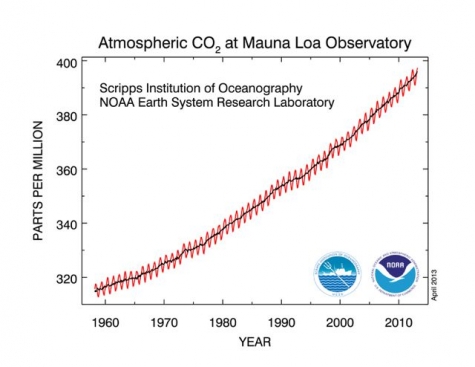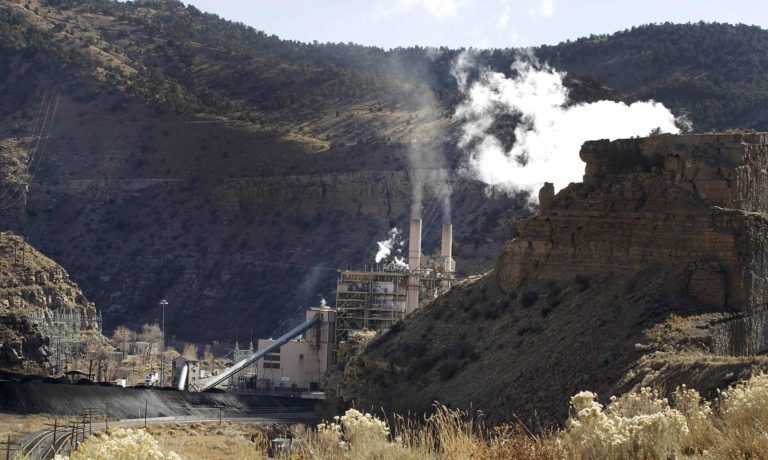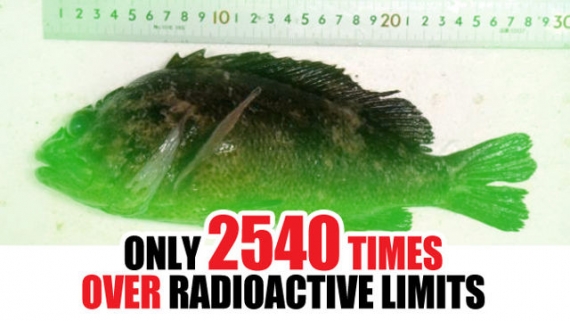By Andrew Freedman
Published: May 3rd, 2013 , Last Updated: May 2nd, 2013
The last time there was this much carbon dioxide (CO2) in the Earth’s atmosphere, modern humans didn’t exist. Megatoothed sharks prowled the oceans, the world’s seas were up to 100 feet higher than they are today, and the global average surface temperature was up to 11°F warmer than it is now.
As we near the record for the highest CO2 concentration in human history — 400 parts per million — climate scientists worry about where we were then, and where we’re rapidly headed now.
According to data gathered at the Mauna Loa Observatory in Hawaii, the 400 ppm mark may briefly be exceeded this month, when CO2 typically hits a seasonal peak in the Northern Hemisphere, although it is more likely to take a couple more years until it stays above that threshold, according to Ralph Keeling, a researcher at the Scripps Institute of Oceanography.
CO2 levels are far higher now than they have been for anytime during the past 800,000 years.
Credit: Scripps Institution of Oceanography.
Keeling is the son of Charles David Keeling, who began the CO2 observations at Mauna Loa in 1958 and for whom the iconic “Keeling Curve” is named.
Carbon dioxide is the most important long-lived global warming gas, and once it is emitted by burning fossil fuels such as coal and oil, a single CO2 molecule can remain in the atmosphere for hundreds of years. Global CO2 emissions reached a record high of 35.6 billion tonnes in 2012, up 2.6 percent from 2011. Carbon dioxide and other greenhouse gases warm the planet by absorbing the sun’s energy and preventing heat from escaping back into space.
The news that CO2 is near 400 ppm for the first time highlights a question that scientists have been investigating using a variety of methods: when was the last time that CO2 levels were this high, and what was the climate like back then?
There is no single, agreed-upon answer to those questions as studies show a wide date range from between 800,000 to 15 million years ago. The most direct evidence comes from tiny bubbles of ancient air trapped in the vast ice sheets of Antarctica. By drilling for ice cores and analyzing the air bubbles, scientists have found that, at no point during at least the past 800,000 years have atmospheric CO2 levels been as high as they are now.
That means that in the entire history of human civilization, CO2 levels have never been this high.
The Keeling Curve, showing CO2 concentrations increasing to near 400 ppm in 2013.
Credit: NOAA.
Other research, though, shows that you have to go back much farther in time, well beyond 800,000 years ago, to find an instance where CO2 was sustained at 400 ppm or greater.
For a 2009 study, published in the journal Science, scientists analyzed shells in deep sea sediments to estimate past CO2 levels, and found that CO2 levels have not been as high as they are now for at least the past 10 to 15 million years, during the Miocene epoch.
“This was a time when global temperatures were substantially warmer than today, and there was very little ice around anywhere on the planet. And so sea level was considerably higher — around 100 feet higher — than it is today,” said Pennsylvania State University climate scientist Michael Mann, in an email conversation. “It is for this reason that some climate scientists, like James Hansen, have argued that even current-day CO2 levels are too high. There is the possibility that we’ve already breached the threshold of truly dangerous human influence on our climate and planet.”
Sea levels are increasing today in response to the warming climate, as ice sheets melt and seas expand due to rising temperatures. Scientists are projecting up to 3 feet or more of global sea level rise by 2100, which would put some coastal cities in peril.
While there have been past periods in Earth’s history when temperatures were warmer than they are now, the rate of change that is currently taking place is faster than most of the climate shifts that have occurred in the past, and therefore it will likely be more difficult to adapt to.
A 2011 study in the journal Paleoceanography found that atmospheric CO2 levels may have been comparable to today’s as recently as sometime between 2 and 4.6 million years ago, during the Pliocene epoch, which saw the arrival of Homo habilis, a possible ancestor of modern homo sapiens, and when herds of giant, elephant-like Mastadons roamed North America. Modern human civilization didn’t arrive on the scene until the Holocene Epoch, which began 12,000 years ago.
Regardless of which estimate is correct, it is clear that CO2 levels are now higher than they have ever been in mankind’s history. With global CO2 emissions continuing on an upward trajectory that is likely to put CO2 concentrations above 450 ppm or higher, it is extremely unlikely that the steadily rising shape of the Keeling Curve is going to change anytime soon.
“There’s an esthetic to the curve that’s beautiful science and troubling reality,” Keeling said. “I’d very much like to see the curve change from going steadily upward to flattening out.”







